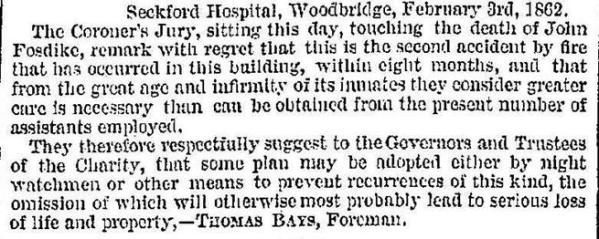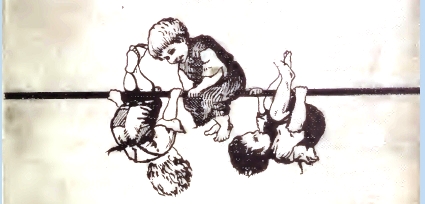Elderly[1] women, in their combustible dresses and aprons, were vulnerable to the dangers of the fire. Nearly all these accidents occurred from clothing catching fire from a spark or falling coal, or from falling into the fire, whilst they rested by the fireside. Others occurred while they went about their domestic tasks. Nearly all of these elderly victims were alone at the time of catching fire; they were often too infirm to extinguish the flames themselves and were severely burnt before assistance was gained such that death often ensued within a few hours of the fatal incident.
In Ipswich, 1846, 88-year-old widow Mary Banks, ‘who resided alone in a small tenement’ was believed to have been sitting too near to the fire-grate when ‘her clothes ignited’. Her daughter and neighbours, hearing the alarm of fire, ‘ran into the house’ and found Mary ‘dreadfully burnt’. ‘She was undressed, and put to bed, but expired in the course of a few hours, surgical assistance being of no avail’.[2] Four years later, one July morning, in 1850, 84-year-old widower, Elizabeth Taylor was ‘sitting alone by the grate, when in getting up to put on some coals, a cinder caught her dress, and set it on fire’. She ‘came to the door of Isaac Giles, a shoemaker, exclaiming “Fire! Fire!”… Her clothes were burning from the waist, the smoke and flames covering her head’. Giles extinguished the flames with a piece of carpet, and soon after Elizabeth was put to bed. However, she died the next day ‘about 12’.[3]
Frances Hearn of Ipswich, though only aged 57, was ‘paralysed and almost entirely helpless’ and suffered an accident similar in circumstance to those befalling the elderly. Her tailor husband worked away from home during the day with Frances being watched over by a neighbour, Mrs Jacobs. On the day of the accident, ‘[Mrs. Jacobs] had been at work in the [Hearn’s] house all the morning, she visited the deceased again about three o’clock in the afternoon. [Frances] was sitting too close to the fire, and Mrs. Jacobs moved her further back’. She returned to her house and at ‘about half-past four […] sent her son into the [Hearn’s] house to see how the fire was getting on. He found the room quite full of smoke’. Frances Hearn was lying dead on the floor, having been burnt to death.[4] Undoubtedly, neighbours, such as Mrs Jacobs, helped to prevent numerous domestic accidents involving the vulnerable and elderly residents of working-class communities or, at least, came to the aid of a neighbour before the accident proved fatal.
As with numerous accidental domestic burnings involving children,[5] many of the aforementioned burns accidents involving the vulnerable and elderly occurred due to exposure to an unguarded fire. Seckford Almshouses, Woodbridge, was the scene of a number of such accidents. In 1870, 84-year-old Peggs Alderton, who, it was noted, ‘was suffering mentally and bodily from the infirmities of old age, and was not in a fit state to be left alone without some protection from the fire’, caught light whilst sitting in a chair by the fireside during her husband’s temporary absence. She was found by her husband ‘lying by the side of the fire with her head in the cinder-pit. Her clothes around her neck and cap were burnt off, and the other part of her clothes smouldering. She was quite dead’. After returning a verdict of accidental death, the jury drew ‘the attention of the trustees [of the Almshouse] to the expediency of fixed guards being placed in front of the fire-places in the rooms inhabited by the old and infirm inmates’.[6] This, however, was not the first occasion where a coroner’s jury had raised the issue of inmates’ safety to Seckford Almshouse trustees. In 1862, after the fatal burning of an elderly inmate, foreman of the jury Thomas Bays wrote to the Governors and Trustees of the almshouse[7]:
Nevertheless, it appears as though the advice went unheeded. In 1885, Sarah Leech, aged 11 years, on visiting her grandmother, another inmate of Seckford Almshouses, was ‘endeavouring to do her hair in front of the fire’ when her clothes ignited. The burns ‘were of such a terrible character that she died [that] same evening’. Significantly, there was no fireguard present. At the inquest, ‘the Jury returned a verdict of “Accidental Death,” adding the presentment to the effect that fireguards should be provided to each grate’. It was then further noted that ‘some 11 years ago an old gentlemen was burnt to death in the Almshouses, which, the Coroner remarked, gave increased force to the recommendation of the Jury’.[8]
In some cases, however, little could be done to prevent such accidents if the elderly person had a child-like inquisitiveness with fire. Septuagenarian Ann Kerridge’s ‘impaired mental faculties’ rendered her impervious to the dangers of fire. Leaving for work one July day, her 74-year-old farm labourer husband ‘cautioned’ her ‘not to touch the fire’. The inquest noted that Ann was ‘fond of poking the fire about whenever she had an opportunity, and had, only the day before, a hole burnt in her dress, but fortunately her husband was then present and extinguished the flames’. However, on this particular day, Ann was as usual left alone; a neighbour discovered her ‘in a blaze’. Badly burnt, ‘she died in about three hours’.[9]
[1] The definition of ‘old age’ is highly subjective and naturally varies greatly across the centuries – today we see those in their 80s as ‘old’, while in the 19th century, with a much lower life expectancy, anyone in their 60s would have been considered old; although, the experience of old age varied widely, affected by class, gender, and physical ability. Sonya Rose, ‘The Varying Household Arrangements of the Elderly in Three English villages: Nottinghamshire, 1851-1881’, Continuity and Change, 3 (1998), 101-122 (p. 118); Pat Thane, ‘Social Histories of Old Age and Ageing’, Journal of Social History, 37 (2003) 93-111 (p. 98); Pat Thane, Old Age in English History: Past Experiences, Present Issues (Oxford, 2000) pp. 4-5; Robert Wood & Nicola Shelton, An Atlas of Victorian Mortality (Liverpool, 1997), p. 119.
[2] Ipswich Journal, 14 Feb 1846, p. 2
[3] Ipswich Journal, 20 Jul 1850, p. 3.
[4] Ipswich Journal, 30 March 1878, p. 5.
[5] See Vicky Holmes, ‘Absent Fireguards and Burnt Children: Coroners and The Development Of Clause 15 Of The Children Act 1908′, Law, Crime And History 2 (2012), 21-58.
[6] Ipswich Journal, 31 Dec 1870, p. 8.
[7] Ipswich Journal, 8 Feb 1862, p. 5.
[8] Ipswich Journal, 25 July 1885, p. 5.
[9] Ipswich Journal, 23 July 1864, p. 5.
Please do not reproduce the content of this blog in print or any other media without permission of the author.

